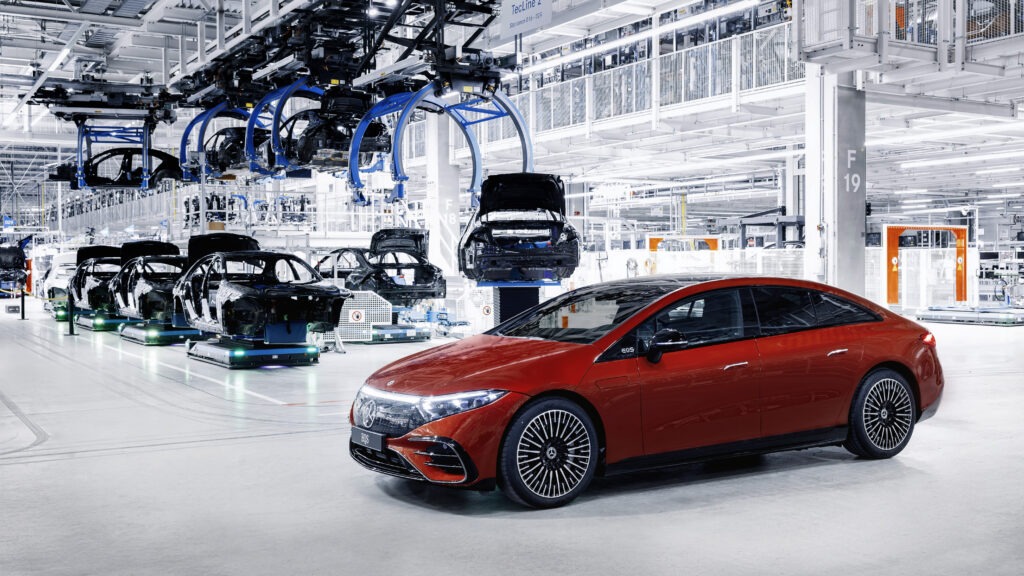Global automotive market enters the electric disruption zone
30 May 2023

Battery-electric vehicles (BEVs) and plug-in hybrids (PHEVs) are claiming an increasing share of global new-car registrations. José Pontes, data director at EV-volumes.com, analyses the electric disruption in March and the first quarter of 2023.
Global plug-in vehicle registrations, including BEVs and PHEVs, were up 28% in March 2023 compared to March 2022. There were 1,097,000 units registered, making it the second-best month ever for plug-in electric vehicles (EVs), behind only December 2022.
Plug-in models claimed an overall market share of 16%, with BEVs alone accounting for 12%. BEVs represented 72% of plug-in registrations in March, pulling up its first quarter share to 68%. Plugless hybrids (HEVs) also surpassed the one million mark in March, rising to 1,004,000 units. This is a first for the powertrain, which means that in total, over two million units, or 31% of the global market, was electrified in some form in March.
Between January and March, the plug-in EV market share grew slightly to 13%, with BEVs accounting for 9% overall. These impressive plug-in figures mean the global automotive industry is now in the electric disruption zone. As plug-in vehicles continue to grow in popularity, the automotive industry is seeing an increasing rate of change.
Record results in March
There were no surprises among the top three best sellers in March. The Tesla Model Y was high above everyone else with a new all-time EV record of 145,306 registrations. This made it the best-selling car in March, all powertrains included, beating global best sellers like the Toyota Corolla and RAV4.
This time, the Tesla Model 3 (second) managed to beat the BYD Song (third) and ended above the Chinese SUV, thanks to Tesla’s usual end-of-quarter push. The BYD Qin Plus came fourth, ending just 150 units behind its sibling. Due to a recent refresh and, maybe above all else, a price cut, sales of the sedan jumped in March, with the PHEV version hitting a new record (31,325 units).
Another two BYD models, the Yuan Plus (otherwise known as the Atto 3 in many export markets) and the Dolphin, also hit record results, coming in fifth and sixth respectively. This is thanks to good results in China, but also increasing volumes in export markets.
But the BYD models were not the only ones hitting new heights, as coming in seventh, the GAC Aion S scored its second record result in a row, this time with 26,393 registrations. Highlighting GAC’s positive moment, the Guangzhou make placed its other star player, the Aion Y, in 11th place.
More records were established further down the best-selling list in March. The Geely Panda Mini ended the month in 15th with 10,550 registrations in only its second volume month. Geely’s take on the Wuling Mini EV can be expected to make a dent (or, depending on the impact, a giant hole) in the Wuling Mini EV’s sales.
Denza’s D9 large MPV experienced a production ramp-up, with 10,398 registrations logged in March. The model ended the month in 16th place. Meanwhile, Changan’s answer to the Tesla Model 3, the Shenlan SL03, came in 19th, hitting a record 9,575 registrations.
Remaining in China, the MG4 production ramp-up allowed it to show up on the table, in 20th, with the hatchback scoring a record 9,247 registrations. It can be expected to continue rising in the table, possibly reaching a top 10 spot sometime in the future.
On the legacy front, Volkswagen (VW) Group models shone brightly. Besides the usual presence of the VW ID.4, which ended the month in ninth, the VW ID.3 surged to 13th thanks to 11,674 registrations. The Audi Q4 e-Tron achieved its first top 20 presence, in 18th, thanks to a record 10,142 registrations.
Outside of the top 20, Hyundai and Kia saw good results. The Kia EV6 reached 8,634 registrations and Hyundai’s Ioniq 5 gained 8,909 registrations. Meanwhile, the BAIC EU-Series recorded 8,135 registrations and the Buick Velite 6, 7,206 registrations. The BAIC model passed the positive results of BMW’s current best sellers, the iX3 (6,330 registrations) and i4 (6,177 registrations).
Other models are also on the rise, with the BYD Frigate 07 (6,455 registrations), Peugeot 208 EV (6,554 registrations), Jeep Wrangler PHEV (6,439 registrations), and Toyota bZ4X (5,674 registrations) all scoring record results.
Meanwhile, the Smart #1 crossover, is starting to reach significant volumes, having delivered a record 6,229 units in March. With volume European deliveries starting soon, there is a chance the quirky model will start showing up in the top 20.
Finally, Li Auto’s L7 five-seat, full-size SUV landed last month, with a significant 7,702 registrations. The startup’s smaller (yet still five-metres long) model can be expected to appear on the best sellers list soon.
World’s best-selling EVs
In the first quarter of 2023, there was nothing new in the top three, with the Tesla Model Y ruling supreme above the BYD Song. The Chinese SUV did keep enough distance from the Tesla Model 3 to resist its end-of-quarter peak and keep the silver medal.
Despite the significant price cuts, sales of Tesla’s sedan grew a mere 4% year over year (YoY), which confirms that the Model 3 is now in its mature stage and only a significant refresh could spark sales once again. But the midsize sedan’s deliveries are not on a downward trend, something that cannot be said about the Model S or Model X flagship models. Despite also benefitting from significant price cuts last quarter, these larger and higher-end Tesla saw its sales drop by 27% in the first three months of 2023.
The BYD Qin Plus jumped two positions. The sedan benefitted from recent price cuts and climbed to fifth place. Keeping an impressive streak, GAC’s Aion S surpassed the BYD Han and climbed another position, to eight. Two positions below, the VW ID.4 did the same to the BYD Tang and was up to 10th.
While BYD’s flagship models seem to be losing charge, Denza’s D9 model is on the rise, with the large MPV from BYD’s premium brand jumping four positions, to 14th. It is unlikely to beat the current full-size leader, BYD’s Han. But having scored close to 25,000 registrations in the first quarter, equating to an annual pace of over 100,000 units a year, the D9 is starting to reach Toyota Alphard/Sienna sales levels, which is already significant.
It is behind the big Chinese minivan that the fun starts, with several models changing positions and two fresh faces in the top 20. The Changan Lumin jumped two positions, to 15th. Meanwhile, below it, legacy OEM models made a move, with three vehicles jumping positions, starting with the VW ID.3 joining the table in 16th place. The ID.3’s premium cousin, the Audi Q4 e-Tron, joined the best sellers table for the first time, in 18th place.
Additionally, the Hyundai Ioniq 5 climbed two positions, to 17th. This means there were five legacy OEM models in the top 20, three of them coming from VW Group. Could 2023 be the year legacy OEMs start clawing their way back into best-seller positions in the plug-in market as they fight for their future in a BEV-based world?
Tesla on top
In March, BYD failed to reach above 200,000 units, which was not enough to beat Tesla. The US carmaker reached a new record score of 207,655 registrations. These two companies may fall into a pattern for the rest of the year, with Tesla winning the end-of-quarter months when it benefits from its usual delivery peak, and BYD winning the remaining stages.
Below these top two, BMW returned to third, with 40,787 registrations, thanks to consistent performances across its line-up. The German carmaker’s highlights were the i4 and iX3, both achieving more than 6,000 registrations in March. The compact iX1 is currently in ramp-up mode, so BMW can be expected to continue expanding its sales throughout the year.
Meanwhile, VW benefitted from positive performances from its dynamic duo, the ID.3 and ID.4, reaching fourth position in March. It scored 40,278 registrations, only 500 units behind BMW. March saw a very close race for the last podium place, because in fifth, GAC only lost out to BMW by 756 units. The Chinese carmaker continued to benefit from the recent sales surge of its Aion S sedan, posting its second record performance in a row.
In eighth, SAIC had a positive month, with over 26,000 registrations, thanks to the ramp-up of the new MG4. The model was responsible for over a third of SAIC’s deliveries. In a time when the Wuling Mini EV seems to be losing steam, a lot of SAIC’s success now falls on the hatchback’s shoulders.
The second half of the table saw three legacy OEMs reach record results. In 14th place, Hyundai scored 21,866 registrations, supported by the positive performances of its best-selling models. In 17th, Toyota recorded a record 13,316 registrations, thanks mostly to the ramp up of its Chinese operations (bZ4X and bZ3). With Toyota currently the third largest brand in China (and second before the rise of BYD), it needs to ramp up its EV operations fast — or else it could say goodbye to the million-plus units it sells in the market.
In 16th place, Peugeot moved 15,138 units, thanks to the record performance of the 208 EV, but the 2008 EV and 3008 PHEV also helped. Meanwhile, the stylish 408 PHEV crossover-fastback production ramp-up is starting to reach volume numbers (698 units last month) and could be another driver for growth for the French brand.
Still in the Stellantis stable, Jeep is profiting from record sales of the Wrangler PHEV (thanks in no small part to IRA incentives in the US) and the production ramp-up of the Grand Cherokee PHEV (3,167 units). This meant the brand reached a near record score of 13,040 registrations in March, beating its US counterparts Ford and Chevrolet.
Brand performance in first quarter
In the first quarter of 2023, BYD pulled ahead of Tesla. Combined, the two are responsible for more than a third of the global plug-in market. Far below, BMW is comfortable in third, while below it, VW surpassed a slowing SGMW and returned to the fourth.
GAC’s rise continued, climbing to sixth, and this could continue considering that fifth place SGMW is just 600 units ahead and the two brands in the joint venture, SAIC and GM Wuling, which are following opposite sales trends. But not everything is bad news for Shanghai Auto, because the mother brand was up one spot, to 10th, partly compensating for the slowdown in its partnership.
In the second half of the table, the Stellantis brands made notable progress. Jeep climbed one position, to 16th, while Peugeot benefitted from its record performance in March to jump four positions and end the quarter in 17th. So, the multinational conglomerate placed two representatives in the best seller’s table. Just outside the top 20, another legacy OEM was on the rise. Toyota is now in 21st, with 28,900 registrations.
Comparing the current ranking with what was happening a year ago, the highlights included BYD’s rise to first place, gaining an impressive market share of 20.4%, compared to 15.5% a year ago. GAC and Changan climbed the rankings, from 12th to sixth and 14th to ninth respectively. Li Auto became the darling among the Chinese new blood, jumping nine spots in a year, and Geely continued to rise, from 17th in March 2022 to its current 12th spot.
Interestingly, three out of the four new brands now present in the top 20 are legacy brands. Nissan and Ford returned to the best sellers table, and Jeep is currently experiencing its best plug-in moment ever.
It should be noted that all four exiting brands that left the table since March 2022 were Chinese makes (Dongfeng, Great Wall, Chery, and XPeng). This could mean the Chinese market is going through a period of consolidation, with more sales going to fewer brands, following a boom period when a new brand seemed to pop up every week.
Top selling OEMs
Looking at registrations by OEM in the first quarter, leader BYD lost significant share, dropping to 21.3%, while Tesla was up, reaching a 16.5% share. This is all thanks to Tesla’s usual end-of-quarter peak. Compared to what happened a year ago, when the two brands were neck and neck, BYD’s lead is now clear.
But there is good news for Tesla too, because after years of a slowly descending market share, it climbed YoY. Its share rose from 15.5% a year ago to its 16.5% in the first quarter of 2023. So, the price cuts did have a positive impact on sales, even if that is entirely on the shoulders of the Model Y.
Third place is in the hands of VW Group, with the German OEM gaining 0.2% on the way to 7.4%. Meanwhile, in fourth, Geely–Volvo dropped slightly (6.1%, down from 6.2%), but a year ago, it was fifth, with a share of just 5.5%.
The same cannot be said about SAIC. Although it kept its fifth position, it lost another 0.2%, dropping to 5.5% in March. Compared to the first quarter of 2022, the Shanghai OEM lost 3% market share and dropped two positions in the OEM table. With 4.9%, Stellantis sits firmly in the sixth and is hoping SAIC’s sales slide will continue, allowing it to return to the OEM top five.
Looking just at BEVs, Tesla* remained in the lead, with 23.6% in March, up from 22% in February. The US brand has a comfortable lead over BYD (14.7% in March) making it unlikely the Chinese carmaker will be able to remove Tesla from the BEV throne this year.
Third place saw a position change, with VW Group (7.5% share in March) surpassing SAIC (7.4%, down 0.4%). Geely–Volvo came in fifth with 5.7%. The Chinese OEM is looking to reach fourth, but still has some ways to go.
*Looking at Tesla sales by regional market in the first quarter, there is one big surprise. Expectations might have been for US Tesla sales to jump through the roof, thanks to the IRA incentives (making its domestic market the brand driver for growth in 2023). However, it turned out the biggest growth market for the brand was Europe. Tesla had 59% growth year on year in Europe, followed by the US (37%) and China (28%).
While the growth in Europe is a positive surprise, above its expected 50% rate, the US increase of 37% is underwhelming. Is this because US buyers are not ready for mass EV adoption, or is Tesla already reaching the natural limits of its domestic market?
With the Model Y having been the best-selling crossover in the US in the first quarter, and the Model 3 the second best-selling sedan in the same period, only behind the Toyota Camry, there is not much more room for Tesla to grow in the country. This means the Cybertruck is badly needed for the brand to continue growing at the same pace as it has so far.
With Tesla possibly reaching its natural limits in the US, other OEMs must now contribute to quicker EV adoption in the region. So far, there has been a greater focus on other parts of the world where there is greater demand and stronger fuel economy requirements.
But in these locations models are not discriminated against when it comes to incentives. It is up to local brands to ramp up production of existing models and quickly introduce and increase production of upcoming ones.



